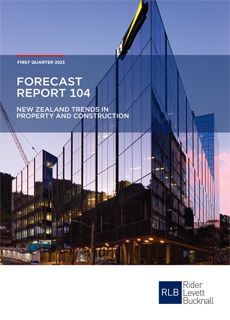According to the Rider Levett Bucknall (RLB) Forecast 104 report – New Zealand Trends in Property and Construction – the weakening in construction demand is becoming more apparent, although there remains a solid pipeline of construction work for the remainder of 2023.
Prepared by the New Zealand Institute of Economic Research (Inc.) (NZIER) exclusively for Rider Levett Bucknall (RLB), Forecast 104 found that construction activity will ease over the coming years, with some offset from the rebuilding expected in 2024 in the wake of the severe weather events in early 2023.
RLB Director, Mr Grant Watkins commented, “There are signs of an easing in the pipeline of construction work, although we still expect a solid pipeline for the coming year. Dwelling consent issuance is easing from high levels, particularly in Auckland where the annual number of dwelling consents issued have fallen to just below 21,000.”
“Dwelling consent issuance in Canterbury has also fallen in recent months. The fall in dwelling consent issuance over the past year has been concentrated in standalone houses. This reflects the shift in demand towards medium-density housing given the scarcity of centrally located land,” he added.
Demand for housing dampening
According to Forecast 104, consent issuance for townhouses and flats has also eased in more recent months. Higher interest rates and tighter access to finance have dampened demand for housing, with house price declines in the main North Island centres of Auckland and Wellington particularly sharp over the past year.
House price declines are expected to broaden across the New Zealand regions. Lower house prices should further reduce the incentive for property developers to bring new housing supply onto the market.
Challenging environment for construction sector
Mr Grant Watkins continued, “Recent announcements of the liquidations of building and construction companies, including Scarbro more recently, highlight the challenging environment firms in the construction sector are operating in. Cost pressures and the lumpy nature of construction projects often heightens the risk of cashflow crunches. Liquidations have flow-on impacts onto creditors who will likely miss out on getting paid and clients whose projects will not be completed.”
RLB expects rebuilding in the wake of the damage from the extreme weather events will gather momentum from 2024 and contribute to construction demand. The extreme weather events over early 2023 have meant a reprioritisation of infrastructure investment given the damage to roading. Beyond the rebuilding, the investment focus for both the government and private sector is also turning from climate change mitigation to climate change adaptation and building resilience.
There also remains robust demand for the construction of social housing from Kainga Ora, with the $3.8 billion Housing Acceleration Fund1 including initiatives for Kainga Ora to develop supporting infrastructure and work with the private sector, iwi and Maori, not-for-profit sector and local government to deliver more affordable housing.
Construction activity declining due to higher interest rates
Even with this rebuilding activity and demand for social housing, RLB expects overall construction activity will decline over the coming years. This decline will be driven by lower residential construction demand as the impact of higher interest rates gain traction in the New Zealand economy.
There are also other signs that the key concern for building sector firms is shifting from capacity pressures to one of weaker demand, with 64 per cent of building sector firms reporting sales was the primary constraint on their business in the March quarter. This is well above the 20 per cent of building sector firms reporting finding labour as the primary constraint on their business. Prior to this, labour shortages had become increasingly acute as the COVID-19 pandemic progressed, with over 57 per cent of building sector firms reporting that as the main constraint on their business in June 2022.
Supply chain disruptions had also been a key concern for firms over the COVID-19 pandemic, but this looks to be largely resolved with only 2 per
cent of building sector firms reporting materials as the primary constraint on their business in the March quarter. This is well below the peak of 26 per cent in September 2021, and adds to other signs that capacity pressures are easing in the construction sector.
Demand for office buildings fuels non-residential construction demand
Over the past year, growth in non-residential construction demand continues to be driven by stronger demand for office and storage buildings. Supply chain disruptions during the COVID-19 pandemic led businesses to focus on bolstering the resilience of their supply chains. Meanwhile, demand for the construction of health facilities also increased over the past year, reflecting the effects of the COVID-19 pandemic and an ageing population. There was also growth in demand for alterations to social buildings. This growth contrasts with the reduced demand for the construction of accommodation and industrial buildings over the past year.
Growth in building consents concentrated in Auckland, Waikato and Canterbury
According to Forecast 104, growth in non-residential construction consent issuance has been concentrated in Auckland, Waikato and Canterbury. Strong demand for the construction of office space and healthcare facilities drove the growth in non-residential construction consent issuance in Auckland.
Meanwhile, in Waikato stronger demand for storage buildings was a key driver of growth in non-residential construction consent issuance. The growth in non-residential construction consent issuance in Canterbury was broad-based across many sectors, with particularly strong demand for social and storage buildings, as well as healthcare facilities and industrial buildings.
This growth more than offsets weaker demand for education and accommodation buildings in the region. In contrast, non-residential construction consent issuance in Taranaki fell over the past year, largely reflecting weaker demand for healthcare facilities in the region.
Construction cost inflation continues to moderate
Non-residential construction cost inflation continued to ease on an annual basis in December 2022. The 1.8 per cent increase in non-residential construction costs over the quarter saw annual non-residential construction cost inflation moderate to just over 10 per cent for the 2022 calendar year.
Mr Watkins said, “We expect construction cost inflation will continue to moderate from current high levels over the coming years. There are signs of capacity pressures easing in the construction sector, as the reopening of international borders help to alleviate labour shortages and supply chain disruptions are resolved.”
“RLB expects this easing in capacity pressures will reduce cost pressures in the construction sector. Nonetheless, annual non-residential construction cost inflation is expected to remain above 5 per cent at the end of this year, given the high inflation environment of the New Zealand economy,” he added.
He concluded, “Beyond 2023, we expect a continued easing in capacity pressures in the construction sector will drive annual non-residential construction cost inflation to below 3 per cent in late 2026.”
FURTHER INFORMATION:



